Teen Room Refresh
/Nate’s room refresh, including how he stores Lego!
Read MoreSpring basics for kids from our favorite shops.
Read MoreThe easiest way to make your own colorful wooden toys.
Read MoreSimple gingerbread play dough using what you already have.
Read MoreDid you know that family photo books are a great way to encourage reading?
Read MoreA simple art project for the whole family.
Read MoreAll the deets on Ruby’s rainbow pumpkins.
Read MoreEverything you want to know about wooden blocks.
Read MoreIf you are looking for a resource packed with CREATIVE ways to use what you already have at home, this post is for you.
Read MoreBeing bored is a gift. It’s free, and yet, the most valuable treasure you can bestow. Being comfortable with boredom is a practice. In the beginning it hurts a little. When you are a parent, there’s a space where you think you need to just jump in and provide direction. Just wait. Ride through. Be there on the other side. Know your child can handle it. They might whine. It might be annoying. There might be a mess to clean up afterwards. What happens when you provide the mental and physical space for your child to be bored?
What are your fears around children being bored? What are we afraid might happen?
Trust me, I know how challenging it can feel to have bored kids. Sometimes, we feel it is our duty as parents to provide our children with constant entertainment. We take them to the newest movie, the arcade, the trampoline park. We line up playdates and sign them up for lots and lots of classes. We pack our Saturdays and Sundays with well-intentioned activities designed to keep our children occupied. We spend our hard-earned dollars on trips to the science center and and fair. We never want our children to idle, less they become… BORED.
Okay, I am being a little dramatic. But I want to make a point about our parental fear of children getting bored. Stay with me.
Often, when my children are bored, they fight with one another. They nudge and irritate and it drives me NUTS. I am always tempted to jump in and give them something to do. I try really hard not to and here’s what that looks like in our home:
If I am feeling impatient, I separate them to their rooms or different areas of the house. Usually, in their solitude, they find something to do. My six year old will typically cry and pout and stomp around in her room. She will come out a few times and try to get me to change my mind. I always send her back up. The reason? I know that when she tolerates her uncomfortable feelings and lets them pass, she will eventually start to play. Sometimes, she’ll cuddle her lovey for comfort and that action in itself will begin a game of fantasy play.
When my oldest gets sent upstairs, he stares out the window. He is dreamy by nature and the new, tween moodiness factor is giving him lots of time to dream in his room. He has drawing materials and Lego up there, and even at eleven years old, can get deep into the creation zone.
Ruby, my middle child, loves art. She keeps a drawer full of her favorite supplies under her bed and when she is up there alone she loves to read, make origami and color. (And glare at me if I dare poke my head in…).
When my children are complaining of being bored, here is what I say:
You are bored? Hmm, I wonder what you’ll do…
Bored, huh? Do you need help coming up with some choices of what to do? The playroom is open, your room is open, and art in the kitchen is open. Which one sounds the most appealing right now?
Bored…? Maybe you can get a drink of water and think about what you did last time you felt bored.
Not sure what to do..? Hmm, let’s think this one out. Do you feel like you want to play alone or with someone?
-With someone? Okay, can you go see what Ruby is up to and if she will include you in her ideas?
-Alone? Can you think of something you would like to build or make and set yourself up?
HERE IS WHY I USE THIS LANGUAGE:
I want to model how to think about being bored. It does not need to be met with agonizing tears or fear. In scaffolding my thought process out loud, I am teaching my children how to meet their own needs around feeling bored.
SOMETIMES IT DOESN’T WORK:
If they are not going for it and are continually coming back to me I will say,
If you truly cannot figure it out, I am happy to choose for you. I have a list of chores that will keep you feeling busy and not bored. Do you want to start by collecting all the dirty laundry or vacuuming the rug?
That usually sends them running off with their next great idea.
Let’s imagine our young children as teenagers for a moment… They have the freedom to roam and are responsible for occupying themselves for much of the day. How do you want your child to feel at the prospect of a wide open day? Will they be anxious and feel the need to fill the hours with instant gratification on their phone or gaming device? Do you want their developing brains to crave constant external stimulation? Will they feel a sense of panic at the prospect of having NOTHING to do?
When kids are comfortable and well-practiced at being bored, they are able to look inside themselves for stimulation. They are comfortable thinking, writing, creating, hiking, etc. None of those activities offer instant gratification. But they do offer much more.
Of course, there will be external stimulation and plenty of instant gratification in the lives of our children. That is the world we live in. BUT… as their childhood brains develop, it feels really important to me to teach them to be comfortable being bored. They must learn to allow their developing brains to rest and stretch and GROW.
Some of the best ideas are born from boredom. Creativity thrives after a period of boredom. Our children need the opportunity to hear their own thoughts. That listening happens in the quiet moments of “boredom”.
I hope you found this post helpful. If you want to hear more from me, please be sure to subscribe to my blog and join the conversation over on Instagram.
-Lizzie
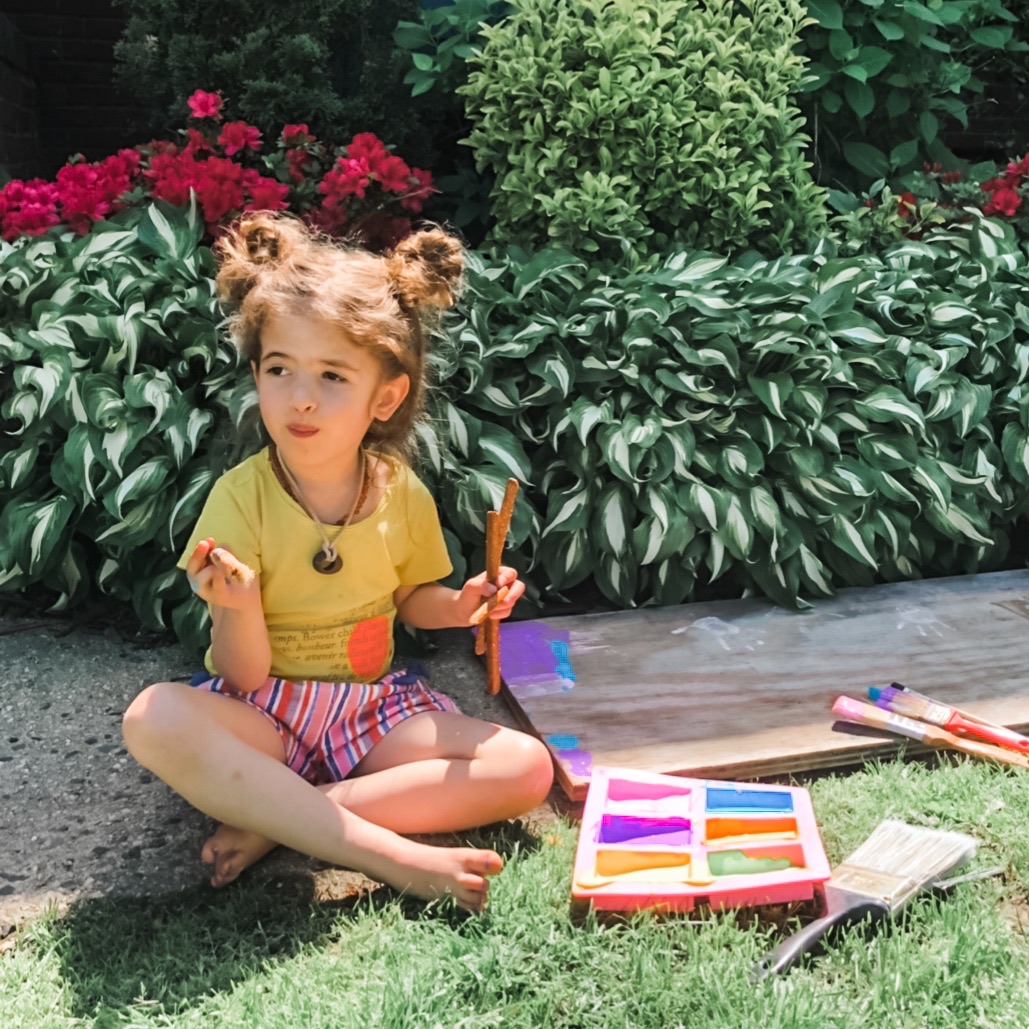
Slow afternoons are my favorite. Preparing a large, healthy-ish snack and setting out an art or play-prompt gathers my crew and the children who tag along with them. I love a full yard of kids. Yes, it’s messy and chaotic. But it also creates a wonderful sense of love and community. I like creating a safe, fun space where my kids can bring their friends to play and unwind. I’m going to miss the crazy one day, so I’m embracing it while I can.
Here are my top tips for creating an environment where children and adults love to come together.
SNACK TIME
Prepare a healthy-ish snack, and lots of it! I like to do a tray of cut up fruit- watermelon or summer cherries are always a big hit. Pair the fruit with a crunchy dry snack like a big bag of popcorn, pirates booty, or pretzels. Then add a “treat” which might be chocolate chip cookies, popsicles or mini Trader Joe’s ice cream cones on a hot day.
I bring out a big pitcher of icy water or juice boxes and a fat black sharpie marker. A marker? YES. This way everyone can label their cups/ juice boxes and you avoid waste and confusion.
ACTIVITY
Put out a SIMPLE activity to draw the children in when they first get home. The trick here is to use what you have, keep it very simple and inexpensive. Pay attention here…. DON’T put a lot of effort into it. That way you won’t be annoyed if they ignore the activity and run off to scooter. It also ensures that you won’t feel put-out or burned out over time.

SIMPLE YARD ACTIVITIES
My go-to is usually chalk, mallets, brushes and water (SEEN HERE). The kids can draw with chalk, or smash it up and make chalk paint. This activity is great for all ages. There are few kids I know who can resist the mallet to smash up some chalk… so therapeutic!
Sometimes, I’ll dig around in the garage and find old wood scraps and bring out hammers and nails and rubber bands. If they get super into it, I’ll add paint or sharpies.
Another simple one is a large thrifted mirror and paint sticks (SEEN HERE). Not messy, very engaging and lots of children can work on it at a time. Bonus? Clean up is a snap. You just need to hose it all down at the end.
GROWN-UP HANGS
With full tummies and after some time spent relaxing with the activity, the children all usually grab bikes, scooters and wagons and take off running and playing. This gives the adults a chance to catch up and get some much needed grown up conversation in.
LIMIT SETTING
Sometimes, I don’t mind if the children wander in and out of the house…. But sometimes, my house is clean and I want it to stay that way. We set clear limits about whether or not going in the house is allowed. I’ll just say, “Our house is closed today, sorry!” OR “It is an outside-only day.” Setting clear and firm limits regarding what you are comfortable with is KEY to enjoying big get togethers and not dreading them.
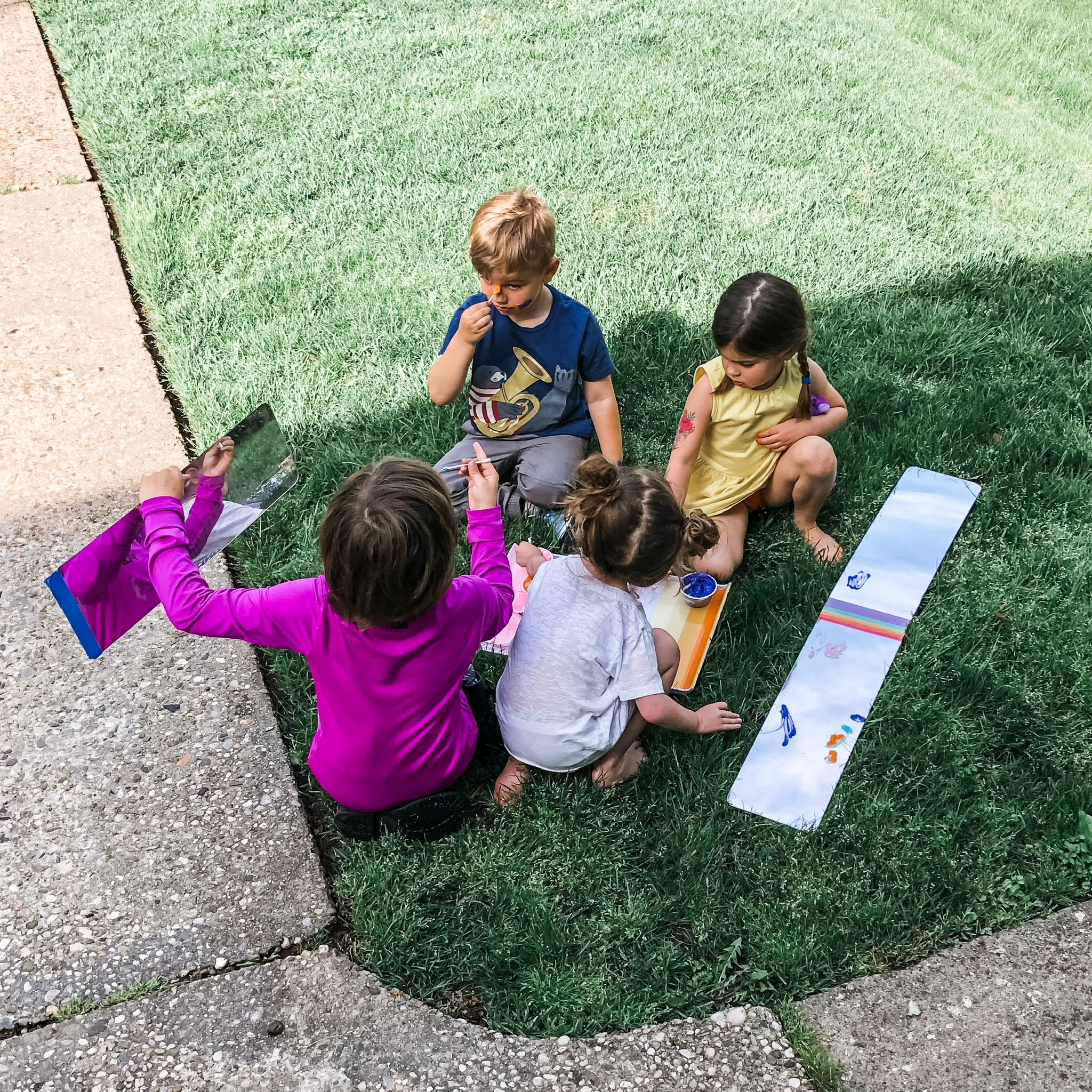
I am extremely lucky to live on a dead end street with lots of awesome families. My favorite Spring afternoons are spent on the front lawn with the dog running up and down fetching a ball while the kids get dirty and have a blast. Of course, there are many tantrums thrown, kids who argue, and skinned knees. But that’s just part of the fabric.
Do you have any neighborhood favorites? Tips for gathering your favorite crew of people? Share them with us!
I hope you found this post helpful. If you want to hear more from me, please be sure to subscribe to my blog and join the conversation over on Instagram.
-LIzzie

How happy are your kids when you say YES to playing in the mud?
Mine are practically levitating when they see a great mud puddle and they get the nod from me.
I know, I know, it’s wet, A MESS! But you know what? It’s totally worth it. I’ll tell you why.
Playing in mud is FUN. Good old fashioned fun. No phones, no iPads, just kids, nature and squeals of delight.
Playing in the mud is FREE. Do you know any other material that costs nothing, can be used wet, dry and somewhere in between? Oh wait, there’s sand at the beach… But unless you live at the beach, it’s back to good old mud.
Playing in the mud is HEALTHY. Studies show that when children play in the mud they are healthier. It’s totally true. Google it. I dare you.
Mud is readily available. Especially in the Spring when April showers bring… you guessed it! MUD.
Mud can certainly stain. So if it’s warm out, I would strip the kids down to their skivvies or an old bathing suit that you no longer care about. If it’s still cold, we love THESE awesome rain pants from our friends over at Biddle and Bop.
Set limits that you are comfortable with and encourage your children to communicate with you and with one another. Some children like splashing and covering each other and some are much more tentative. Model language for cooperative play before diving in and moderate a discussion among the children about what is and is not allowed. While mud play is certainly exciting and fun, it doesn’t have to be an out of control free-for-all.
Keep a clean towel on hand. Sometimes, a big splash can be uncomfortable or get in the eyes. Having a clean towel on hand makes it easy to recover and get back to playing.
Have a set of mud tools. Old thrifted pots and pans, shovels, and buckets. They are simple to source from thrift stores and enhance the play so much!
A large bin of soapy warm water for when you are all finished. The warm soapy water and rags are for your children to clean up most of the mud before coming inside to bathe. This saves you from having to clean your floors and tub. Trust me, I’ve learned this the hard way.
An empty laundry basket for stripping outside, BEFORE entering the house.
You can absolutely allow mud play WITHOUT A GIANT MESS.
Communicate your limits and set them. Stick to it. Trust me, your children will do basically anything to be allowed to get muddy.
Explain that you know how much fun it is, but also, that in order to do it over and over, it needs to be kept to a level that you are comfortable with.
My favorite phrase when my kids are getting a bit out of control is this: “Make me want to say YES next time. If you listen now, I will want to say yes to mud again and again.” I use this kind of strategy in many situations. It is a skill that you actually can teach with repetition. Remind them afterwards, “Remember when I asked you to stop playing and get cleaned up? You listened, and that made me know we can definitely do this kind of play again!” Also, randomly pepper these anecdotes into your daily conversations. At random times, I’ll remind my children about how much fun we had and WHAT MADE IT WORK. Remind them of how they listened and helped. Remind them of how much fun they had. Children love to be set up for success. Use it to your advantage.
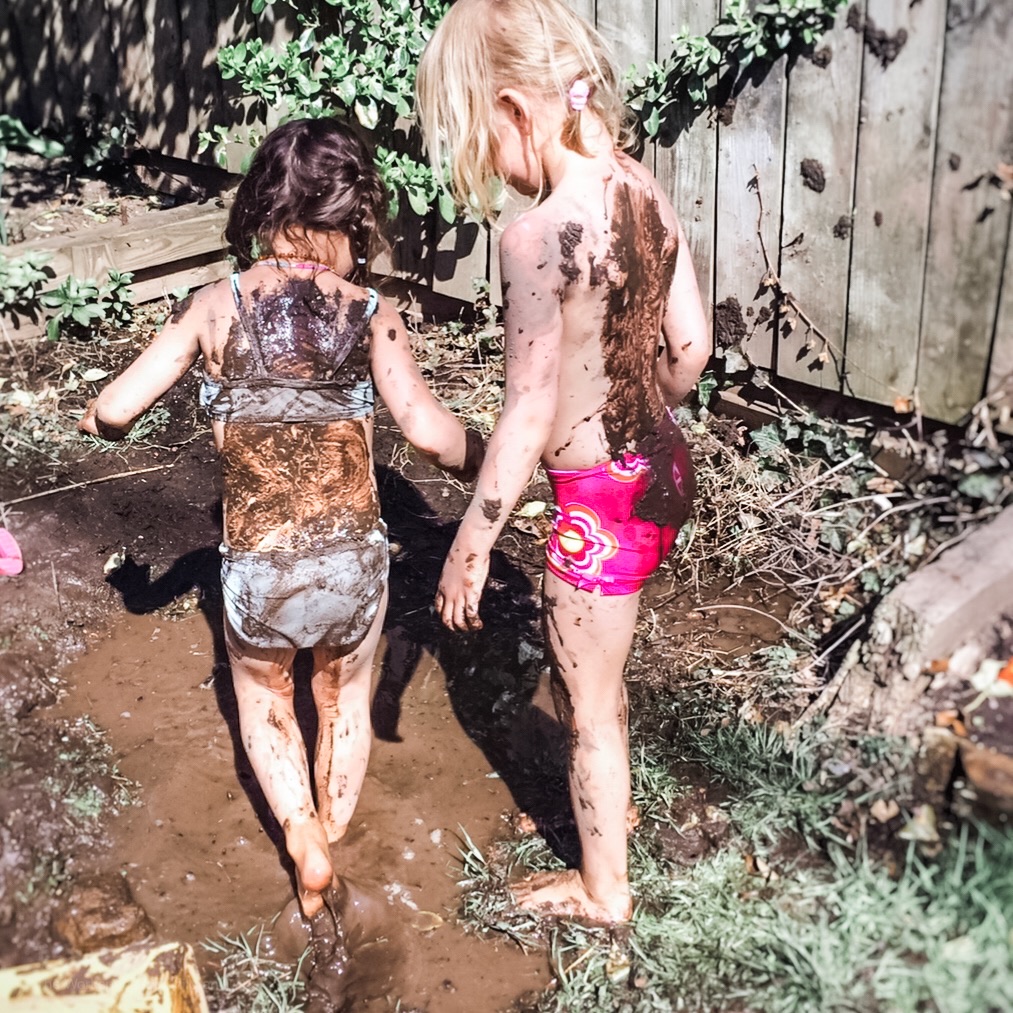
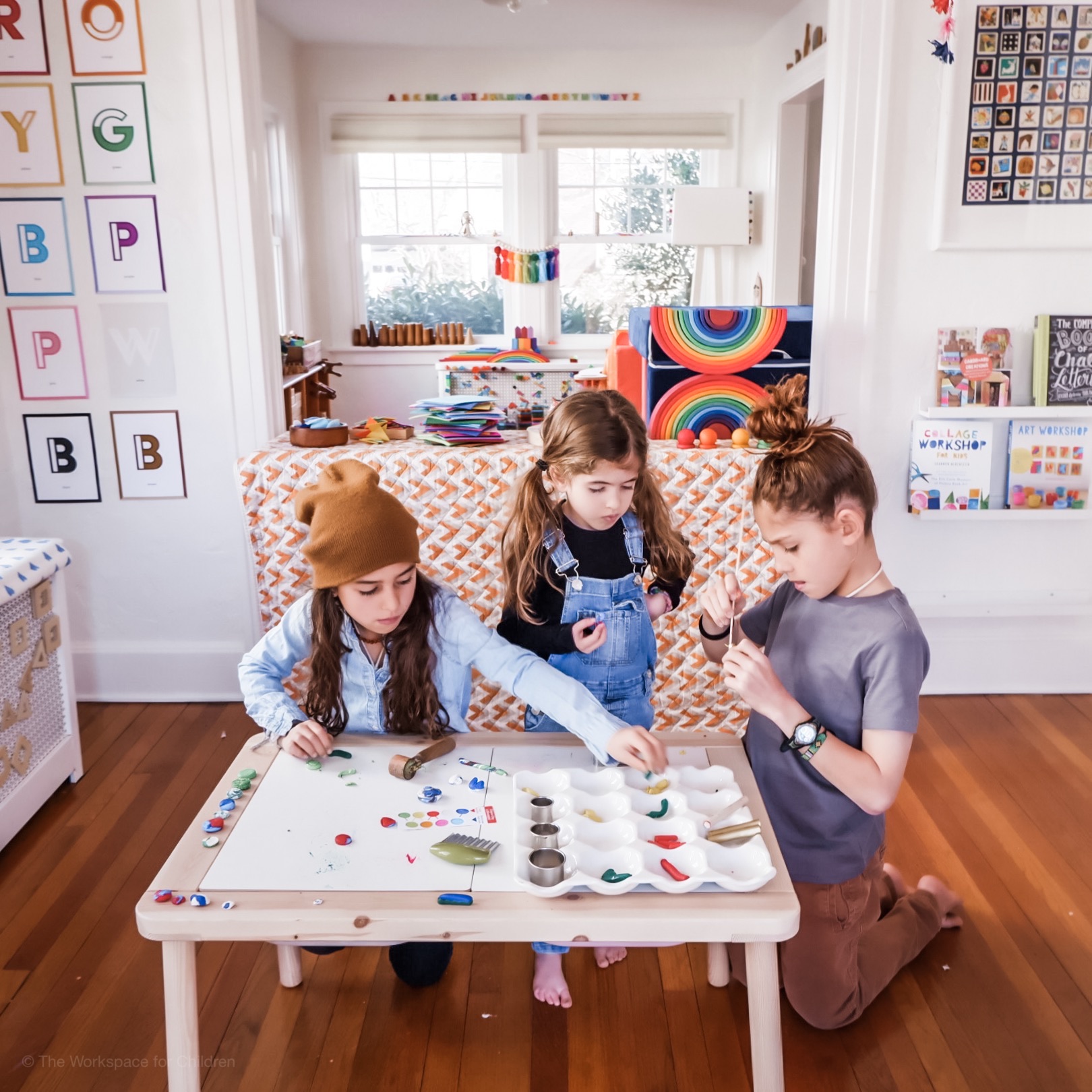
I don’t know about you guys, but my kiddos wake up early on the weekends. Last Saturday everyone was up by seven. It was too early to play outside or go anywhere, and I’d already said no to TV. I wanted an activity that would be good for all three children (ages six, nine and eleven) and I really didn’t want to start my weekend with a big mess to deal with. I pulled out our Crayon Clay that was sent to us from The Pencil Grip and set up a tray of our favorite materials. I find that how you approach the set up of any invitation to create actually does matter. Doing a little bit of extra work on the front end really pays off. Sure, I could’ve just opened the box and given them the packets of clay, but then there would’ve been fighting and whining and lots of requests for help.
Right away, Ruby (nine) knew that she wanted to mix the perfect shade of color. At first, she was frustrated. It took some time and string fingers to get that clay to blend. But when it did, it was so good.
Sloane wanted to make a set of circle crayons for a friend. She rolled the clay and then cut out little circles of color. I think they turnout great!
Nate made little a little snail crayon because he loved the idea that it could leave a trail of color.
When they were finished creating, we left the shaped clay on the table to dry and off we went. It dried beautifully (took about 12 hours) and the children now have a new set of crayons!!
This set is my new go-to birthday gift. It’s a great price point, and can be used by such a large range of ages. I am all stocked up! Click the images (affiliate links) below to find out where to get everything!!
I hope you found this post helpful. If you want to hear more from me, please be sure to subscribe to my blog and join the conversation over on Instagram.
-Lizzie
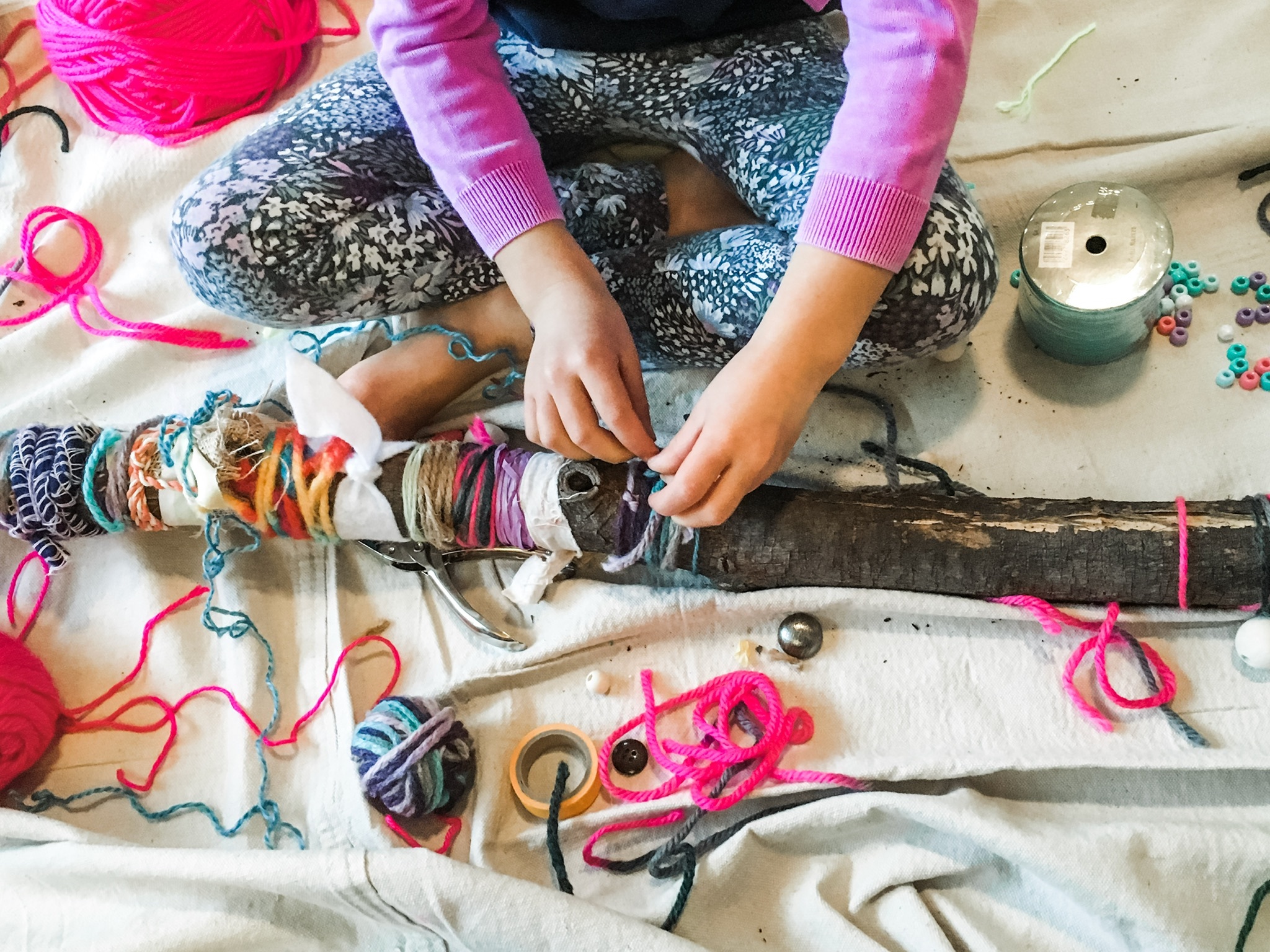
I love this project because everyone in the family can contribute in some way. It is perfect for a snow day spent at home, or a long afternoon in the summer when you’ve got nothing but time on your hands .
In this particular instance, a large wind storm left us this beautiful branch smack in the middle of the yard. The kids and looked at each other and we knew exactly what to do.
First, we dried out the stick for a few days in the basement where it is dry and hot. This also gets rid of any little bugs that might be hanging out inside.
I threw a big drop cloth on the floor and gathered up our materials. We used yarn, fabric scraps, wire, beads, feathers and anything else the children gathered from our art cabinet.
There really weren’t any directions involved. This was entirely about the process, and it happened to turn out to be so beautiful, that it now lives in our living room. The amazing thing about this stick project is that it has been ongoing for a few years. Whenever we find some fabric, interesting yarn or a bead that we love, one of the children pulls the branch out an adds on to it. There have been many new stick projects started over the years, but for some reason, this one was really magical. Sometimes, I wonder if it has anything to do with the tree that dropped it in our yard.…
How do you use gifts from Mother Earth in your art space?

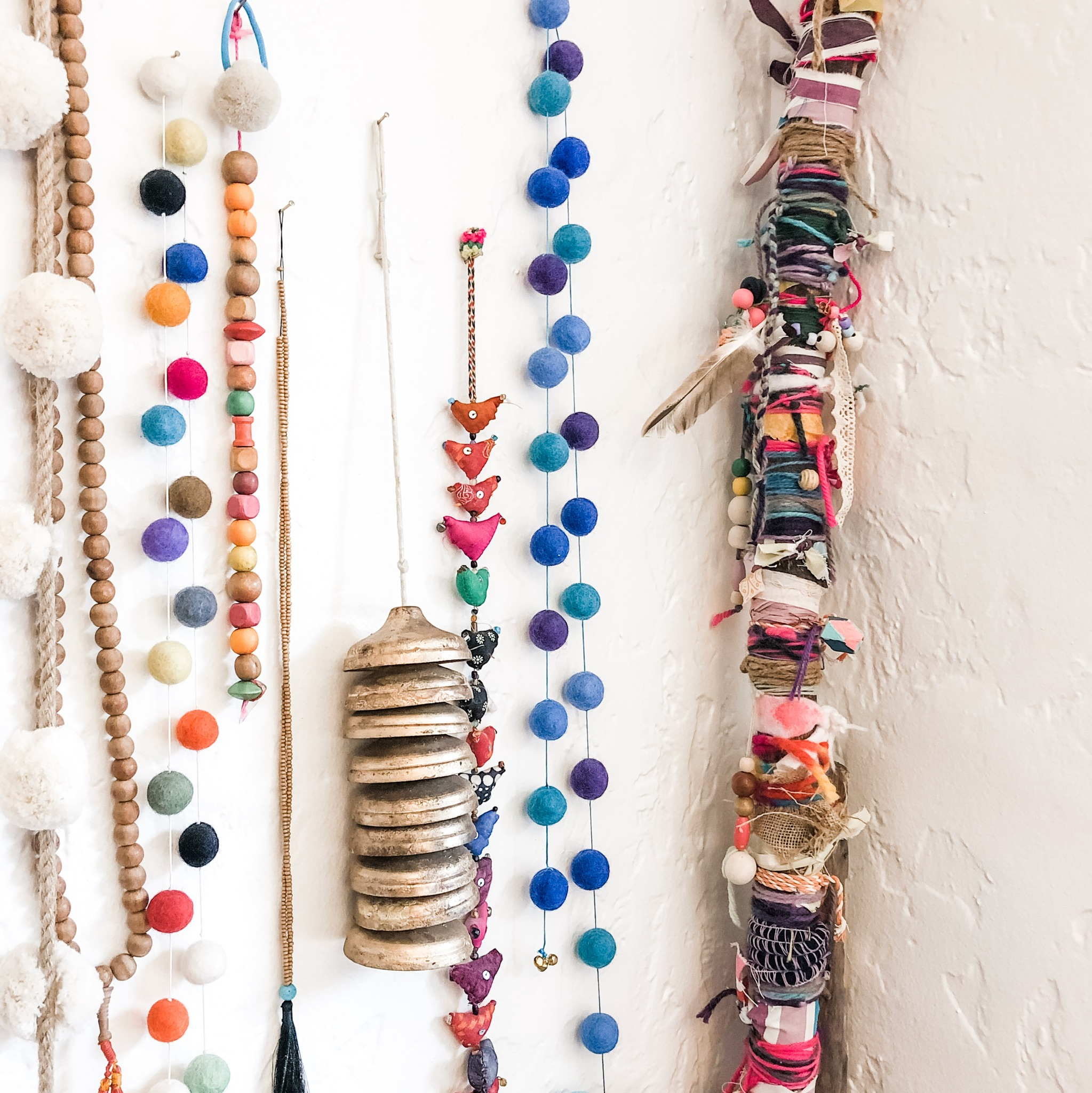
I hope you found this post helpful. If you want to hear more from me, please be sure to subscribe to my blog and join the conversation over on Instagram.
-LIzzie